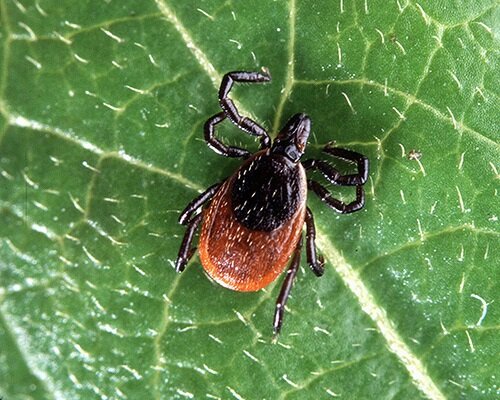It’s Tick Season. Get to Know Your Adversary
Are you smarter than a fifth grader when it comes to deer ticks? While Mainers haven’t taken a quiz from the popular TV show, an apparent drop in Lyme disease cases may be a sign more people are taking precautions against Lyme disease. Preliminary 2015 cases numbered 1,171, down from 1,381 in 2014. Since 2000, deer tick populations have expanded throughout the state, and Lyme disease cases have increased exponentially. The 5- to 14-year-old age group, and those over 65, have been most vulnerable. Learning tick identification is important. The dark brown scutum, or shield on a tick’s back near the head, is a telltale sign that distinguishes deer ticks. Dog ticks, not known to carry diseases in Maine, have white marks on their backs. The next step, learning about deer tick behavior, can be used to outwit this tiny opponent.
Tick Tock
Deer ticks launch a sneak attack on hosts. Latching onto skin with a barbed beak, they inject an anesthetic to avoid detection and an anticoagulant to keep blood flowing. If the deer tick is infected with the Lyme bacteria, it takes 24 to 48 hours to contract Lyme disease. This is why doing daily tick checks is vital.
A Small Opponent
“If you have a freckle that is moving, that’s not a freckle,” Sara Robinson, an entomologist with the Maine Center for Disease Control, commented in a webinar. About the size of a poppy seed, nymphs are challenging to detect. It’s helpful to do tick checks by feel as well as sight. Nymphs emerge in spring, and about half of the Lyme cases occur June through August. By summer, some 30% of deer tick nymphs can be infected with Lyme bacteria. Up to 60% of adult deer ticks can be carriers in the fall.
More than Lyme
Lyme disease, Maine’s second most common infectious disease, is caused by Borrelia burgdorferi, a spiral-shaped bacterium. Deer ticks can carry other infections; cases of anaplasmosis and babesiosis have been rising. Anaplasmosis, a bacteria affecting white blood cells, is treated with antibiotics used for Lyme. Babesiosis, caused by a protozoa infecting red blood cells, requires a two-drug course. Babesiosis can be asymptomatic, or it can cause severe responses – respiratory distress or congestive heart failure, especially in immune-compromised individuals. Co-infections can create atypical symptoms, but flu-like symptoms in summer often indicate a tick-borne illness. The bulls-eye rash caused by Lyme is reported in 56% of Maine cases. When the rash occurs, it’s not always near the tick bite.
Winter Activity
Lyme disease can be contracted in winter; as long as temperatures are above freezing, deer ticks are active. Only adult females seek a blood meal, and those not feeding earlier remain active. Deer are favored hosts, but any large mammal will suffice.
Cutting off Food Supply
Making yards less inviting to deer tick hosts is another strategy. Vegetable gardens are tempting to deer, which also like landscape plantings: tulips, hostas, and rhododendrons. Most deer can’t jump an eight-foot fence. Another approach is plantings deer find less desirable. A guide, rated by deer resistance, can be found at https://njaes.rutgers.edu/deerresistance/. Bird feeders can attract mice, a common host for larval deer ticks. University of Maine Cooperative Extension recommends placing feeders away from the house, or limiting feeding to winter months.
Thirsty?
Dry environments are deer ticks’ nemesis. They can’t drink water. To stay hydrated, they must absorb humidity from the air. Deer ticks often attach behind knees or under arms to avoid drying out. A three-foot wide buffer of wood chips, mulch or gravel is a desert to a deer tick. Blind and unable to fly or jump, deer ticks wait on tall grass and bushes for anything brushing past them. Removing moist environments like leaf litter, tall grass and brush and mowing lawns frequently is recommended. Studies show deer ticks can survive in a washing machine; they just “come out squeaky clean,” Sara Robinson said. They don’t fare well in the dryer. She recommends tossing clothes in the dryer on high heat first.
Protect Yourself
Used on clothing, permethrin is one of five tick repellents approved by the Environmental Protection Agency. Spraying lasts six to eight washings; permethrin-embedded clothing is good for 600 to 1,000. For skin, the EPA suggests DEET, IR3535, picardin, and oil of lemon eucalyptus, an organic repellent. Follow instructions. If a tick becomes attached, remove the entire tick, using tweezers or a tick spoon. Tick spoons, less likely to pull hairs, are recommended for pets and can be purchased here. Maine CDC also has a 24-hour consultation line, 800-821-5821. For more information, visit: click here.

